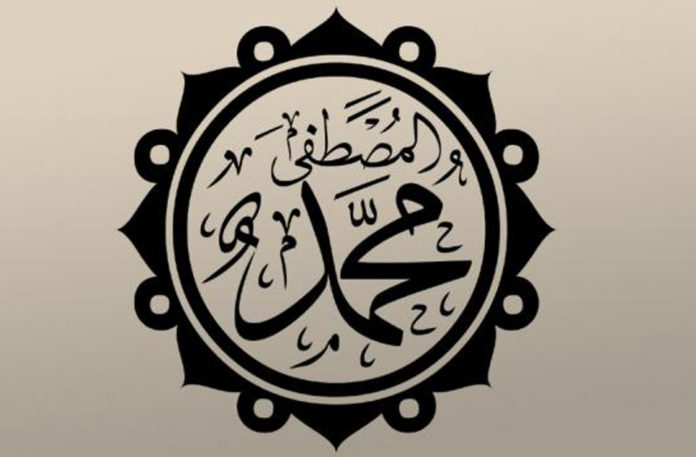Key:
(B) = Bukhârî;
(SM) = Muslim;
(BQ) = Bayhaqî, Dalâ & an-Nubuwwah;
(M) = Munâwî, Sharh Shama´il al-Muhammadiyyah;
(Q) = al-Qârî, Sharh Shama´il al-Muhammadiyyah;
(S) = Suyûtî, Khasâ´is al-Kubra
(Z) = Zurqânî, Sharh Mawâhib al-Laduniyyah;
(H) = ibn Hajr, Fath al-Bâri;;
(AQ) = al-`Ainî,`Umdatu-l-Qârî;
(N) = Nawawî, Sharh Sahîh Muslim;
(A) = al-Albânî, Mukhtasar Shama´il a-Muhammadiyyah;
(IQ) = ibn al-Qayyim, Jalal al-Afham.
§4. Mahmûd bin Ghaylân narrated to us; Wakî` narrated to us; Sufyân ath-Thawrî narrated to us; from Abû Ishâq; from al-Barâ´a bin `Âzib (RA) that he said,
| I have never seen a person having a full head of hair, wearing a red hulla, who looked better than the Messenger of Allâh, ﷺ. He had hair that reached his shoulders and his shoulders were broad. He was neither short nor tall. [1] |
§5. Muhammad bin Ismâ`îl narrated to us; Abû Nu`aym narrated to us; al-Mas`ûdî narrated to us; from `Uthmân bin Muslim bin Hurmuz; from Nâfi` bin Jubair bin Mut`im; from `Alî bin Abû Tâlib (RA) that he said,
| The Prophet, ﷺ, was neither tall nor short. His hands and feet were heavy and thick. He had a large head, large bones and a long line of [fine] hair extending from his chest to navel. When he walked, he leant forward as if descending a slope. I have not seen anyone, before him or after him, who was comparable to him [2] |
“The Prophet, ﷺ, was neither tall nor short. His hands and feet were heavy and thick,” (Q) al-Asma`î explained this to mean having think fingers and toes and al-Hâfi ibn Hajr explained it to mean having thick fingers and palms and mentioned another narration with the wording, “He had large hands and feet,” he said, ‘al-Khattâbî explained it to mean thickness and longness and this is what is intended here.’ It is also narrated from al-Asma`î that he explained it to mean calloused, but when it was said to him that it is narrated that the Prophet’s, ﷺ, hands were soft and tender, he went silent and decided not to explain the word any further. (M) Hence the meaning is that they tended towards being thick without being short or calloused. (Q) Ibn Battâl said, ‘His, ﷺ, hand was fleshy, it was large and thick, but despite this it was soft as is established in the hadîth of Anas recorded in the Sahîh, “I have not touched silk, or silk brocade, that was softer than his hand, ﷺ,” . If we were to accept the explanation of al-Asma`î we would say it is possible that the narrator depicted the hand of the Messenger of Allâh, ﷺ, in different situations: when he fought Jihâd, his hand would become calloused, but otherwise his hand would be in its natural state of being soft.’ al-Qâdî said, ‘Abû `Ubayd, the linguist, explained it to mean thickness of fingers and palm coupled with shortness, but this position was criticised because it is established that he had long fingers.” The hadîth concerning this follows and this is further endorsed by the hadîth, recorded by Bukhâri in ta`lîq form, mentioning that the Prophet, ﷺ, had long hands; the full isnâd for this was provided by al-Bayhaqî, ad-Dalâ´il. The meaning of this hadîth is that his hands and fingers were long without being excessively so. This quality of hand is praiseworthy in men because it means that they have a strong grasp, but blameworthy in women (M) as mentioned by ibn al-Athîr, an-Nihâyah. (Q) Ibn Hajr said, ‘The correct position is that his hands were thick, but not short or calloused.’
(Z)[3] Muslim records that he, ﷺ, stroked the cheek of Jâbir and he said, ‘I experienced a sensation of coolness from his hand and a scent as if he had just removed it from a perfume vendors box.’ Ahmad records that the Prophet, ﷺ, visited Sa`d bin Abi; Waqqâs in Mecca when he was ill and stroked his face, chest and stomach. Sa`d said, ‘To this very hour it seems to me that I can feel the coolness of his hand on my liver.’ al-Bayhaqî and at-Tirmidhî [4 ]record on the authority of Abû Zayd al-Ansârî that the Prophet, ﷺ, stroked his head and beard and supplicated, “O Allâh, make him beautiful,” and even when he had exceeded the age of one hundred, not a single white hair was to be seen on his beard, his face remained of cheerful complexion and never looked perturbed or dejected until the day he died. (B) Abû Juhayfah reports that the Messenger of Allâh, ﷺ, went out to al-Bathâ´ at noon, he performed ablution and prayed Dhuhr as two rak`ahs and `Asr as two rak`ahs, praying towards a short spear beyond which women would pass. The people stood and took hold of his hands and used them to wipe their faces. He said, ‘So I took hold of his hand and placed it on my face and found it to be cooler than ice and its scent to be sweeter than musk.’ (SM) Umm Sulaym reports that the Prophet, ﷺ , used to visit her and have a siesta in her house and she would spread out a leather cloth in which he would lie. He would sweat profusely and she would collect his sweat and put it in perfume. When the Prophet, ﷺ, asked about this she said, ‘It is your sweat which we have put in our perfume, and it is perfume of the sweetest type!’ (H) Abû Ya`lâ and al-Bazzâr record with a sahîh isnâd on the authority of Anas that when the Messenger of Allâh, ﷺ, passed through a road in Mecca, he would leave behind him the fragrance of musk and the people would say, ‘The Messenger of Allâh has passed!’ ﷺ.
“He had a large head, large bones and a long line of [fine] hair extending from his chest to navel” (Q) al-Bayhaqî records the hadîth, “He, ﷺ, had a line of hair extending from his navel to chest, and he had no other hair on his chest or stomach.” “When he walked, he leant forward as if descending a slope,” An explanation of this has preceded and follows in the next hadîth. “I have not seen anyone, before him or after him, who was comparable to him,” (M) One should believe that Allâh created his noble body with an excellence that has not appeared before him or after him, ﷺ. The reason for this is that the good qualities of the body are an indication of what is contained within the body of sublime morals, manners, and attributes, and the Chosen One, ﷺ, reached the peak of all of these. (B) al-Barâ´a reports that ‘The Messenger of Allâh, ﷺ, was the most handsome of people, with the best of builds, he was not very tall, neither was he short.’
§6. Sufyân bin Wakî` narrated to us; my father narrated to us; from al-Mas`ûdî the likes of this with this isnâd.
1 Muslim [Fadâ’il], Abû Dâwûd [at-Tarajjul].
2 Reported by at-Tirmidhî [al-Manâqib]. The sentence, “His hands and feet were heavy and thick,” along with the last sentence are reported by Bukhâri; [al-Libâs] from Anas (RA).
3 Zurqâni; [5/452+]
4 al-Bayhaqi; said it was and at-Tirmidhi; said it was hasan.
(NOTE: If you want to build a strong and powerful relationship with Allah, check out Islamia TV, where you can watch Islamic speakers from across the globe deliver inspiring and motivational courses. Learn more at www.islamia.tv.)






















